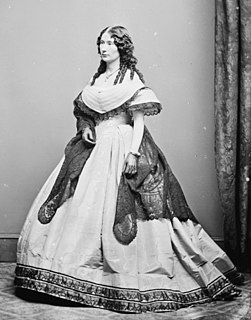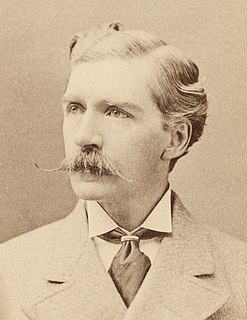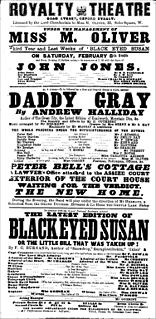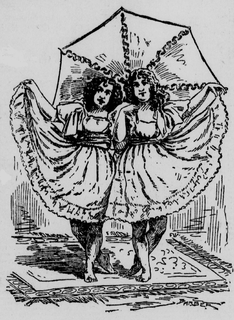Related Research Articles

A burlesque is a literary, dramatic or musical work intended to cause laughter by caricaturing the manner or spirit of serious works, or by ludicrous treatment of their subjects. The word derives from the Italian burlesco, which, in turn, is derived from the Italian burla – a joke, ridicule or mockery.

Laura Keene was a British stage actress and theatre manager. In her twenty-year career, she became known as the first powerful female manager in New York. She is most famous for being the lead actress in the play Our American Cousin, which was attended by President Abraham Lincoln at Ford's Theater in Washington, D.C., on the evening of his assassination.

Edward Askew Sothern was an English actor known for his comic roles in Britain and America, particularly Lord Dundreary in Our American Cousin.

Sir Francis Cowley Burnand, usually known as F. C. Burnand, was an English comic writer and prolific playwright, best known today as the librettist of Arthur Sullivan's opera Cox and Box.

Ira Frederick Aldridge was an American and later British stage actor and playwright who made his career after 1824 largely on the London stage and in Europe, especially in Shakespearean roles. Born in New York City, Aldridge is the only actor of African-American descent among the 33 actors of the English stage honoured with bronze plaques at the Shakespeare Memorial Theatre at Stratford-upon-Avon. He was especially popular in Prussia and Russia, where he received top honors from heads of state. At the time of his sudden death, while on tour in Poland he was arranging a triumphant return to America, with a planned 100-show-tour to the United States

The Black Crook is a work of musical theatre first produced, with great success, in New York in 1866. Many theatre writers have identified The Black Crook as the first popular piece that conforms to the modern notion of a musical, while others regard this conclusion "as something of a joke". The book is by Charles M. Barras (1826–1873). The music, selected and arranged by Thomas Baker, consists mostly of adaptations, but it included some new songs composed for the piece, notably "You Naughty, Naughty Men". The story is a Faustian melodramatic romantic comedy, but the production became famous for its spectacular special effects and skimpy costumes.

Mrs. John Wood, born Matilda Charlotte Vining, was an English actress and theatre manager.

Faust up to Date is a musical burlesque with a score written by Meyer Lutz. The libretto was written by G. R. Sims and Henry Pettitt. It is a spoof of Gounod's opera, Faust, which had first been performed in London in 1864, and followed on from an earlier Lutz musical, Mephistopheles, or Faust and Marguerite.

Pauline Markham was an Anglo-American dancer and contralto singer active on burlesque and vaudeville stages during the latter decades of the 19th century. She began by performing juvenile rôles in Manchester, made her debut on the London stage at 20 and a year later New York as a member of the British Blondes which introduced Victorian burlesque to America, where for a few years she would find phenomenal success before her career settled into a long steady decline.

Martha Cranmer Oliver, also known as Pattie Oliver or M. Oliver, was an English actress and theatre manager.

Little Jack Sheppard is a burlesque melodrama written by Henry Pottinger Stephens and William Yardley, with music by Meyer Lutz, with songs contributed by Florian Pascal, Corney Grain, Arthur Cecil, Michael Watson, Henry J. Leslie, Alfred Cellier and Hamilton Clarke. The comedy lampooned the serious plays based on the life of Jack Sheppard, especially the popular 1839 play by John Buckstone, which was in turn based on the novel of that year by William Harrison Ainsworth.

The first theatre in New York City to bear the name The Winter Garden Theatre had a brief but important seventeen-year history as one of New York's premier showcases for a wide range of theatrical fare, from Variety shows to extravagant productions of the works of Shakespeare. Initially known as Tripler's Hall or Metropolitan Hall, it burned down in 1854 and was rebuilt as The New York Theatre. Although it burned to the ground several times, it rose from the ashes under different managers, bearing various names, to become known as one of the most important theatres in New York history.

Lydia Thompson, was an English dancer, comedian, actress, and theatrical producer.
Thomas Baker was a nineteenth-century composer and musical producer.

The Pretty Druidess; Or, The Mother, The Maid, and The Mistletoe Bough is an operatic burlesque by W. S. Gilbert. It was produced at the opening of the new Charing Cross Theatre on 19 June 1869 and ran until September of that year.

Imre Kiralfy and Bolossy Kiralfy were highly influential burlesque and spectacle producers in Europe and the United States toward the end of the 19th century. The brothers paved the way for many of our modern day spectacles. With backgrounds in music and dance, these performers turned producers dazzled New York City with theatrical wonders. The brothers had a long and successful partnership and even continued to have success in their individual careers. From folk dancing in Europe to directing and producing in the United States, the Kiralfys spent their lives astounding audiences with unseen visual phenomenon and were never afraid to push the boundaries earning them a special place in entertainment history.
Lotty Hough was a 19th-century actress and comedian. She played roles for the companies of Laura Keene and Mrs. John Wood.

The Leigh Sisters was a vaudeville act at the end of the 19th century in the United States.

Mollie Williams was an American burlesque artist and producer. She was best known for producing, writing, and starring in her own revue, The Mollie Williams Show.

The Olympic Theatre was the name given to three former 19th-century theatres in the Broadway district of New York and in Brooklyn.
References
- ↑ Winter, William. Brief Chronicles, Part I, p. 180 (1889)
- ↑ Ashby, LeRoy. With Amusement for All: A History of American Popular Culture Since 1830, pp. 109-10 (2006)
- ↑ Gale, Robert L. A Cultural Encyclopedia of the 1850s in America, p. 216 (1993)
- 1 2 3 Curry, Jane Kathleen. Nineteenth-century American Women Theatre Managers, pp. 70-72 (1994)
- ↑ Creahan, John. The Life of Laura Keene, pp.23 (1887)
- ↑ Allen, Robert Clyde. Horrible Prettiness: Burlesque and American Culture, pp. 105-06 (1991)
- ↑ (November 27, 1860). Amusements (review), The New York Times
- ↑ (November 27, 1860). Dramatic, New York Evening Express, p. 2, col. 6
- ↑ (12 August 1861). City Items, New York Tribune , p. 3, col. 5 (article on closing of play, lamenting that "such a dismal affair would have a run of eight months")
- 1 2 Dudden, Faye E. Women in the American Theatre: Actresses and Audiences, 1790-1870, p. 144 (1994)
- ↑ Grossman, Barbara Wallace. A Spectacle of Suffering: Clara Morris on the American Stage, pp. 39-40 (2009) (production in Cleveland which included a young Clara Morris)
- ↑ Buszek, Maria Elena. Pin-Up Grrrls: Feminism, Sexuality, Popular Culture, pp. 39-40 (2006)
- ↑ Brown, T. Allston. A History of the New York Stage, Vol. 2, pp. 139-40 (1903)